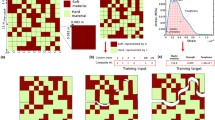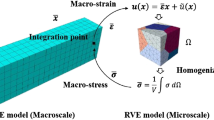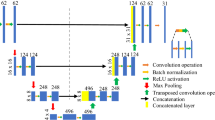Abstract
It is significant to determine the macroscopic mechanical properties of composite materials with complex microstructure efficiently and accurately in many fields. We propose a deep learning method based on three-dimensional convolutional neural network (3D CNN) to predict the elastic coefficients of composite materials with inclusions of arbitrary sizes, shapes and material parameters. 3D datasets are generated, and a storage algorithm is proposed to reduce great storage costs in 3D. A general framework for 3D CNN models is constructed, and numerical experiments are carried out using 3D CNNs of various scales. Our results demonstrate that the scale of full connection part is the key factor of prediction ability of 3D CNNs in this task. We also demonstrate that our method can effectively save computational time compared with traditional numerical methods such as the finite element method in large-scale prediction tasks.










Similar content being viewed by others
References
Tjong SC, Ma ZY (2000) Microstructural and mechanical characteristics of in situ metal matrix composites. Mater Sci Eng R Rep 29(3–4):49–113
Sen O, Davis S, Jacobs G, Udaykumar HS (2015) Evaluation of convergence behavior of metamodeling techniques for bridging scales in multi-scale multimaterial simulation. J Comput Phys 294:585–604
Zhou XY, Gosling PD, Pearce CJ, Ullah Z, Kaczmarczyk L (2016) Perturbation-based stochastic multi-scale computational homogenization method for woven textile composites. Int J Solids Struct 80:368–380
Gokhale AM, Singh H, Shan Z (2006) Microstructure representation and simulation tools for microstructure-based computational micro-mechanics of heterogeneous materials. In: Computational methods, dordrecht, pp 1629–1633
Tagliavia G, Porfiri M, Gupta N (2009) Vinyl ester-glass hollow particle composites: dynamic mechanical properties at high inclusion volume fraction. J Compos Mater 43(5):561–582
Smit RJM, Brekelmans WAM, Meijer HEH (1998) Prediction of the mechanical behavior of nonlinear heterogeneous systems by multi-level finite element modeling. Comput Methods Appl Mech Eng 155(1–2):181–192
Hill R (1965) A self-consistent mechanics of composite materials. J Mech Phys Solids 13(4):213–222
Mori T, Tanaka K (1973) Average stress in matrix and average elastic energy of materials with misfitting inclusions. Acta Metall 21(5):571–574
Xing YF, Du CY (2014) An improved multiscale eigenelement method of periodical composite structures. Compos Struct 118:200–207
Omairey SL, Dunning PD, Sriramula S (2019) Development of an ABAQUS plugin tool for periodic RVE homogenisation. Eng Comput 35(2):567–577
Cheng G-D, Cai Y-W, Xu L (2013) Novel implementation of homogenization method to predict effective properties of periodic materials. Acta Mech Sin 29(4):550–556
Ye S, Li B, Li Q, Zhao H-P, Feng X-Q (2019) Deep neural network method for predicting the mechanical properties of composites. Appl Phys Lett 115(16):161901
Zhou K, Sun H, Enos R, Zhang D, Tang J (2021) Harnessing deep learning for physics-informed prediction of composite strength with microstructural uncertainties. Comput Mater Sci 197:110663
Bargmann S, Klusemann B, Markmann J, Schnabel JE, Schneider K, Soyarslan C, Wilmers J (2018) Generation of 3D representative volume elements for heterogeneous materials: a review. Progress Mater Sci 96:322–384
LeCun Y, Bengio Y, Hinton G (2015) Deep learning. Nature 521(7553):436–444
Wang H, Zhang L, Han J, W E (2018) Deepmd-kit: a deep learning package for many-body potential energy representation and molecular dynamics. Comput Phys Commun 228:178–184
Ryan K, Lengyel J, Shatruk M (2018) Crystal structure prediction via deep learning. J Am Chem Soc 140(32):10158–10168
Moore BA, Rougier E, O’Malley D, Srinivasan G, Hunter A, Viswanathan H (2018) Predictive modeling of dynamic fracture growth in brittle materials with machine learning. Comput Mater Sci 148:46–53
Elapolu MSR, Shishir MIR, Tabarraei A (2022) A novel approach for studying crack propagation in polycrystalline graphene using machine learning algorithms. Comput Mater Sci 201:110878
Liu X, Gasco F, Goodsell J, Yu W (2019) Initial failure strength prediction of woven composites using a new yarn failure criterion constructed by deep learning. Compos Struct 230:111505
Zhang X, Garikipati K (2020) Machine learning materials physics: multi-resolution neural networks learn the free energy and nonlinear elastic response of evolving microstructures. Comput Methods Appl Mech Eng 372:113362
LeCun Y, Boser B, Denker J, Henderson D, Howard R, Hubbard W, Jackel LD (1990) Handwritten digit recognition with a back-propagation network. In: Advances in neural information processing systems (NIPS), vol 2
LeCun Y, Kavukcuoglu K, Farabet C (2010) Convolutional networks and applications in vision. In: Proceedings of 2010 IEEE international symposium on circuits and systems, pp 253–256
Wang Y, Zhang M, Lin A, Iyer A, Prasad AS, Li X, Zhang Y, Schadler LS, Chen W, Brinson LC (2020) Mining structure-property relationships in polymer nanocomposites using data driven finite element analysis and multi-task convolutional neural networks. Mol Syst Des Eng 5(5):962–975
Wei A, Xiong J, Yang W, Guo F (2021) Deep learning-assisted elastic isotropy identification for architected materials. Extreme Mech Lett 43:101173
Glorot X, Bengio Y (2010) Understanding the difficulty of training deep feedforward neural networks. In: In Proceedings of the international conference on artificial intelligence and statistics, pp 249–256
Hara K, Kataoka H, Satoh Y (2018) Can spatiotemporal 3D CNNs retrace the history of 2D CNNs and ImageNet? In: 2018 IEEE/CVF conference on computer vision and pattern recognition, pp 6546–6555
Zhang W, Lin J, Xu W, Fu H, Yang G (2017) SCStore: managing scientific computing packages for hybrid system with containers. Tsinghua Sci Technol 22(6):675–681
Dassault Systèmes Simulia Corp: SIMULIA user assistance 2020 (2020)
Ioffe S, Szegedy C (2015) Batch normalization: accelerating deep network training by reducing internal covariate shift. In: International conference on machine learning. Proceedings of machine learning research, vol 37, pp 448–456
Nair V, Hinton GE (2010) Rectified linear units improve restricted boltzmann machines. In: Proceedings of the 27th international conference on international conference on machine learning, pp 807–814
Srivastava N, Hinton G, Krizhevsky A, Sutskever I, Salakhutdinov R (2014) Dropout: a simple way to prevent neural networks from overfitting. J Mach Learn Res 15:1929–1958
Abadi M, Barham P, Chen J, Chen Z, Davis A, Dean J, Devin M, Ghemawat S, Irving G, Isard M, Kudlur M, Levenberg J, Monga R, Moore S, Murray DG, Steiner B, Tucker P, Vasudevan V, Warden P, Wicke M, Yu Y, Zheng X (2016) TensorFlow: a system for large-scale machine learning. In: Proceedings of OSDI’16: 12th USENIX symposium on operating systems design and implementation, pp 265–283
Kingma DP, Ba J (2015) Adam: a method for stochastic optimization. In: International conference on learning representations
Wager S, Wang S, Liang P (2013) Dropout training as adaptive regularization. Adv Neural Inform Process Syst 26:351–359
Kay W, Carreira J, Simonyan K, Zhang B, Hillier C, Vijayanarasimhan S, Viola F, Green T, Back T, Natsev P, Suleyman M, Zisserman A (2017) The kinetics human action video dataset
Acknowledgements
This work is supported by National Natural Science Foundation of China (Grant No. 12072172 and 11772171).
Author information
Authors and Affiliations
Corresponding author
Additional information
Publisher's Note
Springer Nature remains neutral with regard to jurisdictional claims in published maps and institutional affiliations.
Rights and permissions
Springer Nature or its licensor (e.g. a society or other partner) holds exclusive rights to this article under a publishing agreement with the author(s) or other rightsholder(s); author self-archiving of the accepted manuscript version of this article is solely governed by the terms of such publishing agreement and applicable law.
About this article
Cite this article
Su, H., Guan, T. & Liu, Y. A three-dimensional prediction method of stiffness properties of composites based on deep learning. Comput Mech 71, 583–597 (2023). https://doi.org/10.1007/s00466-022-02253-z
Received:
Accepted:
Published:
Issue Date:
DOI: https://doi.org/10.1007/s00466-022-02253-z




